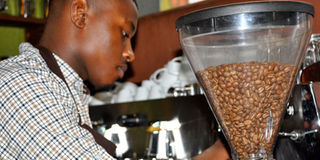Brazil coffee volumes fall, Africa expected to fill gap

There has been a noticeable increase in coffee production in the last three years. Photo by Edgar R Batte
What you need to know:
The increasing coffee production in Africa and other countries will offset the declining output from Brazil, the world’s leading producer.
A report from the International Coffee Organisation for the month ending April indicates that world production in 2017/18 is estimated at 159.66 million bags
The increasing coffee production in Africa and other countries will offset the declining output from Brazil, the world’s leading producer.
A report from the International Coffee Organisation for the month ending April indicates that world production in 2017/18 is estimated at 159.66 million bags.
However, the report indicates that Brazil’s total exports alone, decreased by 10.5 per cent to 2.52 million tonnes in March.
“Between October last year and March 2018, Brazil shipped 16.57 million bags, 7.7 per cent lower than the same period a year ago,” the report shows.
The deficit left by Brazil, the report says, is likely to be offset by coffee exports from other regions, especially Africa.
“Production in Africa is estimated to be 3.2 per cent higher [producing about] 17.66 million bags,” the report shows.
Asia and Oceania countries are expected to post 49.49 million bags which is 10 per cent higher, while Mexico and Central America will export 21.92 million bags. In Africa, Uganda, the leading coffee exporter expects to export five million (60-kilogramme) bags.
“Uganda’s exports declined by 18.7 per cent to 0.33 million bags in March 2018, but its shipments for the first six months of 2017/18 are up by 3.7 per cent compared to the same period one year ago, reaching 2.34 million bags,” the report shows.
This performance, according to experts, is the work of different inputs that have been put in place to improve the sector that seeks to produce 20 million bags per annum by 2025.
Emmanuel Iyamulemye, the Uganda Coffee Development Authority executive director, says the efforts have started bearing fruits but there is need to “invest in agronomical practices such as research, high yielding and disease free-varieties and use of fertilizers to increase our production and rehabilitation of the existing crop”.
Introduction of coffee production to new areas such as northern Uganda, parts of Busoga and greater Bunyoro, he says, will boost the volumes.
UCDA has over seen the plantation of more than 500 million seedlings in the last three to four years and they have started to contribute to volumes.
With all these interventions, Iyamulemye expresses optimism that by end of this year the country would have hit the five million (60) kilogramme bags.
In April, according to the report, composite indicator decreased by 0.4 per cent to an average of 112.56 cents, with the daily price ranging between 110.49 and 114.73 cents (dollar).
Prices for all Arabica groups fell in April, although the largest month-on-month decrease occurred for Brazilian Naturals, which fell by 0.9 per cent to 118.76 cents.
Meanwhile, the monthly average for Robusta, increased by 0.1 per cent to 88.31 cents.
Global coffee exports amounted to 10.81 million bags in March compared to 10.91 million in March 2017, driven by reduced shipments of Arabica, particularly Colombian Milds.
Exports in the first six months of the 2017/18 coffee year fell by 0.6 per cent to 59.96 million bags compared to the same period in the last coffee year.




